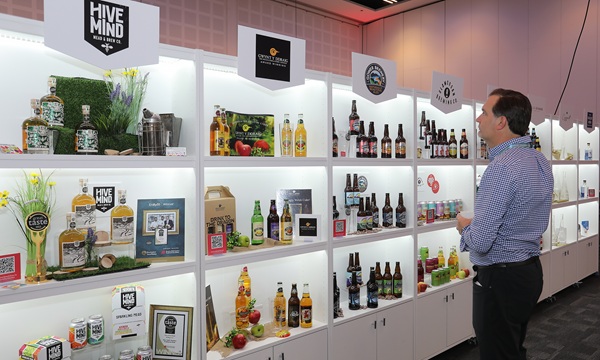
Welsh Heather Honey has become the first honey in the UK to receive the coveted Protected Geographical Indication (PGI) status, a legal designation that protects food and drink products from imitation and misuse.
As a result, Welsh Heather Honey has joined the burgeoning family of food and drink products from Wales that, by virtue of their unique characteristics and location, receive protection under the UK GI (Geographical Indication) Scheme.
There are now 24 Welsh food and drink products that enjoy GI status including PGI Welsh Lamb, PGI Welsh Beef, Carmarthenshire Ham PGI, Traditional Welsh Caerffilli PGI, and Traditional Welsh Cider PGI.
Wales’ Deputy First Minister, Huw Irranca-Davies, who has responsibility for Climate Change and Rural Affairs, said:
“This recognition strengthens Wales’ growing family of protected foods, showcases the extraordinary quality of our produce, and reflects our commitment to high-quality, sustainable food production.
“From the mountains to the coast, Wales produces some of the UK's most iconic foods, cultivated with care and tradition. Each GI product tells the story of our landscape, our producers' expertise and our proud culinary heritage.”
The application for PGI status was made to the UK Government’s Department for Environment, Food and Rural Affairs (DEFRA) by the members of the 15-strong Food & Drink Wales Honey Cluster, who sought to protect Welsh Heather Honey’s unique attributes and, thereby, the livelihoods of those beekeepers whose bees produce the honey.
The Food & Drink Wales Honey Cluster is part of the Welsh Government Cluster Programme, which brings together food and drink businesses, suppliers, academia and government with the key objective of helping businesses collaborate to achieve accelerated growth in sales, profit and improved productivity.
North Wales beekeeper Alex Ellis of Border Honey said:
“Achieving PGI status for Welsh Heather Honey will help producers because it will demonstrate to the public that it is a special and unique product that can only be produced in Wales. Consumers can have confidence that when they choose Welsh Heather Honey they are getting the real thing.”
Gruffydd Rees of Gwenyn Gruffydd Ltd in Carmarthenshire said:
“I am delighted that Welsh Heather Honey’s precise origin and characteristics have been recognised. The UK GI application process is long, and it is wonderful that Wales is the first UK nation to have a honey receive PGI status.”
Dawn Wainwright of Aberystwyth-based Wainwright’s Bee Farm said:
“Heather, Calluna vulgaris, blossoms abundantly across the Welsh mountain uplands during late summer. The bees gather a small harvest of a distinctive aromatic honey from the ling heather flowers with unique characteristics. The chemistry of the heather flower nectar gives the honey a protein content which produces a thixotropic or gel-like texture with crunchy crystals suspended throughout.
“Adding value to Welsh terroir produce, we have supplied this rare honey to Fortnum & Mason for decades and this highly sought after honey has built up a large following. The queen of honeys to honey connoisseurs, we have also brought this single origin honey to Marks & Spencer shelves nationwide.”
Welsh Heather Honey is ‘thixotropic’, which means its structure/texture has a ‘gel-like’ consistency that is very slow to set. This makes the honey difficult to extract, so Welsh Heather Honey is frequently presented as cut comb in honey.
Welsh Heather Honey is reddish-orange to dark amber with a bright – but not clear – appearance and often contains suspended air bubbles. Its flavour is ‘intense sweetness with a touch of bitterness’ and has been described as ‘butter-filled toffee’ or ’sweet burnt caramel’ with an aroma of heather.
To qualify for PGI status, all bee hives – or apiaries – producing Welsh Heather Honey must be located in Wales, and the nectar making up the honey should be foraged from Welsh heather moorlands.
It is produced by the Western Honey Bee (Apis Mellifera), which forage on Welsh heather moorlands where there is a predominance of Ling heather (Calluna Vulgaris) pollen – as opposed to Bell Heather (Erica Cinera). However, pure mono-floral heather honey is rare, as heather nectar is often mixed with small amounts of nectars from other moorland species such as rose bay willow herb, blackberry and gorse.
The Welsh Heather Honey PGI designation only relates to ‘Welsh Heather Honey’, which meets the product specification and does not include other types of honey that have been blended or mixed.
Welsh Heath Honey is unpasteurised to ensure all the enzymes resulting from the natural origin of the honey – and, therefore, its characteristics – are retained, and only minimal filtration is allowed.
The length of the Welsh Heather Honey production season is very weather-dependent and can vary significantly. It is usually produced between July and September. However, depending on the season, the window for obtaining the honey can be very short – sometimes only lasting a matter of days and requiring specific skills. Therefore, volumes are often small, which makes Welsh Heather Honey a rare and premium product.






